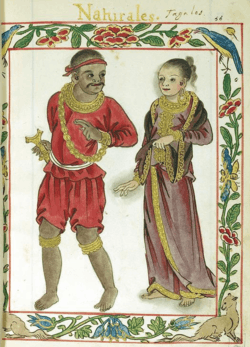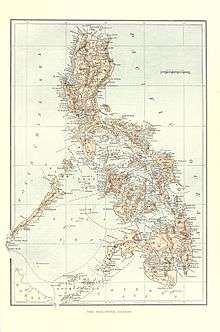Caboloan
Caboloan (also spelled Kaboloan; Pangasinan: Luyag na Caboloan),[1] referred to Chinese records as Feng-chia-hsi-lan (Chinese: 馮嘉施蘭; pinyin: Féngjiāshīlán; Pe̍h-ōe-jī: Pâng-ka-si-lân),[2] was a sovereign pre-colonial Philippine polity located in the fertile Agno River basin and delta, with Binalatongan as the capital.[3] The polity of Pangasinan sent emissaries to China in 1406–1411.[2]
Caboloan Luyag na Caboloan | |||||||||||||
|---|---|---|---|---|---|---|---|---|---|---|---|---|---|
| c. 1406–1576 | |||||||||||||
| Status | Tributary state to Ming dynasty | ||||||||||||
| Capital | Binalatongan | ||||||||||||
| Common languages | Pangasinan, other Northern Luzon languages | ||||||||||||
| Religion | Buddhism, Animism and Folk religion | ||||||||||||
| Government | Monarchy | ||||||||||||
| History | |||||||||||||
• Established | c. 1406 | ||||||||||||
• Spanish conquest of Pangasinan | 1576 | ||||||||||||
| Currency | Silver, Barter | ||||||||||||
| |||||||||||||
| Today part of | |||||||||||||
| Caboloan | |||||||||||
|---|---|---|---|---|---|---|---|---|---|---|---|
| Traditional Chinese | 馮嘉施蘭 | ||||||||||
| |||||||||||
.jpg)
In the 16th century, the port settlement of Agoo[4] in Pangasinan was called the "Port of Japan" by the Spanish.[5] The locals wore apparel typical of other maritime Southeast Asian ethnic groups in addition to Japanese and Chinese silks. Even common people were clad in Chinese and Japanese cotton garments. They also blackened their teeth and were disgusted by the white teeth of foreigners, which were likened to that of animals. They used porcelain jars typical of Japanese and Chinese households. Japanese-style gunpowder weapons were also encountered in naval battles in the area.[6] In exchange for these goods, traders from all over Asia would come to trade primarily for gold and slaves, but also for deerskins, civet and other local products. Other than a notably more extensive trade network with Japan and China, they were culturally similar to other Luzon groups to the south, especially the Kapampangans.
Limahong, a Chinese corsair and warlord, briefly invaded the polity after his failure in the Battle of Manila (1574). He then set up an enclave of wokou (Japanese and Chinese pirates) in Pangasinan. Nevertheless, the Mexico-born Juan de Salcedo and his force of Tagalog, Visayan and Latino soldiers then assaulted and destroyed the pirate-kingdom, liberated the Pangasinan people and then incorporated their polity into the Spanish East Indies of the Spanish Empire.
See also
| Pre-Colonial History of the Philippines |
 |
|---|
| Barangay government |
| Ruling class (Maginoo): Datu (Lakan, Raja, Sultan) |
| Middle class: Timawa, Maharlika |
| Serfs, commoners and slaves (Alipin): Horohan, Alipin Namamahay, Alipin sa gigilid, Bulisik, Bulislis |
| The book of Maragtas |
| States in Luzon |
| Caboloan (Pangasinan) |
| Ma-i |
| Rajahnate of Maynila |
| Namayan |
| Tondo |
| States in the Visayas |
| Kedatuan of Madja-as |
| Kedatuan of Dapitan |
| Kingdom of Mactan |
| Rajahnate of Cebu |
| States in Mindanao |
| Rajahnate of Butuan |
| Sultanate of Sulu |
| Sultanate of Maguindanao |
| Sultanates of Lanao |
| Key figures |
|
| Religion in pre-colonial Philippines |
| History of the Philippines |
| Portal: Philippines |
Notes
- Flores, Marot Nelmida-. The cattle caravans of ancient Caboloan : interior plains of Pangasinan : connecting history, culture, and commerce by cartwheel. National Historical Institute. Ermita: c2007. http://www.kunstkamera.ru/files/lib/978-5-88431-174-9/978-5-88431-174-9_20.pdf
- Scott, William Henry (1989). "Filipinos in China in 1500" (PDF). China Studies Program. De la Salle University. p. 8.
- http://anaknabinalatongan.wixsite.com/anaknabinalatongan/single-post/2014/12/21/History-of-Binalatongan
- de Loarca, Miguel (1582). Relacion de Las Yslas Filipinas.
- Sals, Florent Joseph (2005). The history of Agoo : 1578-2005. La Union: Limbagan Printhouse. p. 80.
- Scott, William Henry (1994). Barangay. Manila Philippines: Ateneo de Manila University Press. p. 187.

